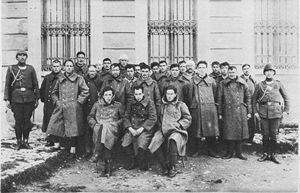Catalogue number 129100
Prisoners from E15
The prisoners shown here are from the British submarine E15. They were captured when E15 attempted to pass through the Dardanelle Straits into the Sea of Marmara. On 17th April 1915, E15 entered the Straits but was caught by strong currents and swept ashore under the Turkish guns at Kephez Point. Firing on the grounded E15, she was hit by shells killing the Captain T. Brody and five other crew. The others surrendered to the Turks and amongst the prisoners was C.E.S. Palmer, previously the British Vice Consul at Chanak (a city on the Dardanelle Straits). As an officer of the Royal Navy Volunteer Reserve, Palmer had insisted on being taken on board E15 and was given the rank of Temporary Lieutenant. Although the Turks had found documents on E15 confirming this rank, the Turks preferred to say Palmer, given his previous functions, was a spy and they threatened to execute him unless he gave information about the planned Allied attack on the Dardanelles. Quick thinking by Palmer had him give information on the real landing place then direct the Turk’s attention to a landing in the Gulf of Saros saying that the original plan had been compromised. In exchange the Turks guaranteed Palmer’s status as a prisoner of war. Palmer was an intelligence officer on the staff of Admiral de Roebeck and the information he gave was false and misled the Turks and their German advisor when the real landing took place. That the British were so insistent in destroying the foundered E15 leads one to believe that she was carrying sensitive documents associated with the mission of Palmer. The submarine B6, two destroyers, another submarine B11 and two battleships were successively sent without success into the Straits to destroy E15 before one of two steam pickets finally blew up E15 with two torpedoes. (references: Liman von Sanders, the Capture of Lieutenant Palmer, and Ottoman Anticipation of the Allied Landings at Gallipoli on 25 April 1915, Tim Travers, The Journal of Military History, Vol. 65, No. 4 2001, pp. 965-979 and Submarine E15, Paul McNeil, Time Detectives Blog, 2015)
Recto: "The captured prisoners of the English submarine from the Dardanelles at Constantinople. Seated between two officers is Palmers (sic), a former English consul in Constantinople." in Hungarian
18.6cm x 12cm Printed image
|
 |